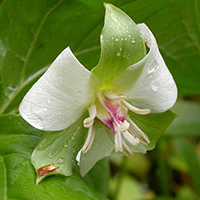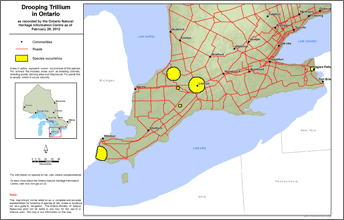Drooping trillium
Scientific name: Trillium flexipes

Cover photo credit: C. D. Jones
Status
Endangered
“Endangered” means the species lives in the wild in Ontario but is facing imminent extinction or extirpation.
Date added to the Species at Risk in Ontario List
The Drooping trillium was already assessed as endangered when the Endangered Species Act came into effect in 2008.
What it looks like
Drooping Trillium is a flowering plant that blooms early in the spring. It grows to a height of 15 to 60 centimetres and has a ring of three leaves around the stem.
It produces a long flowering stalk that ends in a single large, white flower with three petals. The flower can be erect but often “droops” over to one side.
Where it lives
Drooping Trillium grows on damp sandy soil in mature, deciduous forests that are usually close to a river or stream.
It is found in Carolinian forests with Maple, White Ash, Basswood, Hackberry, White Elm, and Blue Ash trees.
It shares the forest floor with other native plants including Ostrich Fern, Wild Ginger and Jack-in-the-pulpit.
Where it’s been found in Ontario
In Canada, Drooping Trillium only grows in southwestern Ontario in the warmer climate of the Carolinian forest.
There were once six known locations in the province, but today there are only two. A total of 1465 flower stems were reported in 2007.
Both populations along the Sydenham River in Middlesex County and along the Thames River in Elgin County are believed to be reproducing successfully.
View a Larger version of this map (PDF)
What threatens it
The greatest threat to Drooping Trillium is habitat loss and degradation caused by urban development or habitat alteration and damage due to recreational activities, such as hiking and ATV use.
White-tailed deer eat Drooping Trilliums, which is a problem in areas where there are large deer populations. Invasive species, such as Garlic Mustard, also threaten this species.
Action we are taking
Endangered Species and their general habitat are automatically protected
Recovery strategy
A recovery strategy advises the ministry on ways to ensure healthy numbers of the species return to Ontario.
Read the executive summary (June 15, 2012)
Read the recovery strategy (June 15, 2012)
Government response statement
A government response statement outlines the actions the government intends to take or support to help recover the species.
Read the government response statement (May 31, 2013)
Five-year review of progress
A five-year review of progress made toward protecting and recovering a species is required no later than five years after the government response statement for that species is published.
Read the report on progress towards the protection and recovery of 17 species at risk, including the Drooping Trillium (2018).
Habitat protection
General Habitat Protection - June 30, 2008
What you can do
Report a sighting
- The Ministry of Natural Resources and Forestry tracks species at risk such as the Drooping trillium. Report a sighting of an endangered animal or plant to the Natural Heritage Information Centre. Photographs with specific locations or mapping coordinates are always helpful.
- Consult the Ministry of Natural Resources and Forestry when working around forests for information on provincial regulations and best management practices to protect these important habitats. Call toll free
1-800-667-1940 or visit the Ministry website.
Volunteer
- Volunteer with your local nature club or provincial park to participate in surveys or stewardship work focused on species at risk.
Be a good steward
- Private land owners have a very important role to play in species recovery. If you find Drooping trillium on your land, you may be eligible for stewardship programs that support the protection and recovery of species at risk and their habitats.
- Invasive species seriously threaten many of Ontario’s species at risk. To learn what you can do to help reduce the threat of invasive species, visit:
www.ontario.ca/invasivespecies
www.invadingspecies.com
www.ontarioinvasiveplants.ca - The Carolinian forests of southern Ontario support an amazing diversity of plants and wildlife, including many species at risk. Carolinian Canada is working to help recover species at risk and their habitats. For more information, visit:
www.carolinian.org/SpeciesHabitats.htm.
Report illegal activity
- Report any illegal activity related to plants and wildlife to
1-877-TIP-SMNR (847-7667) .
Quick facts
- Drooping Trillium seeds are dispersed by ants and possibly by white-tailed deer. The ants carry the seeds back to their nests, eat the outer casing and then discard the seed.
- Drooping Trillium was once thought to have disappeared from Ontario. It was rediscovered in the early 1990s, but is still considered very rare.
- Drooping Trillium may take up to 10 years to produce flowers.
